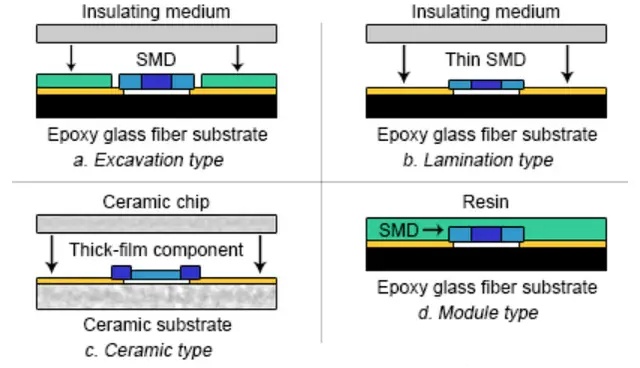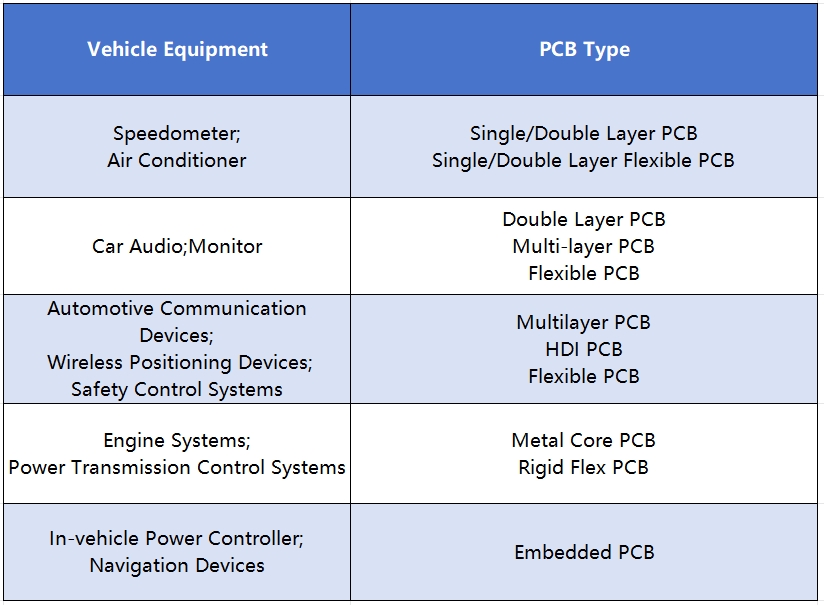Automotive Electronics PCB Related Knowledge
Manufacturing Characteristics of Automotive PCB
1. High Frequency Substrate
Automotive collision avoidance/predictive braking safety system plays the role of military radar equipment.
Since automotive PCBs are responsible for transmitting microwave high-frequency signals, substrates with
low dielectric loss need to be used along with the common substrate material PTFE. Unlike FR4 materials,
PTFE or similar high-frequency substrate materials require special drilling speeds and feed rates during the drilling process.
2. Thick Copper PCB
Due to high density and high power and hybrid power, automotive electronics bring more heat, and electric vehicles
often require more advanced power transmission systems and more electronic functions, thus placing higher demands
on heat dissipation and high current.
It is relatively easy to fabricate thick copper double-layer PCBs, while it is much more difficult to fabricate thick copper
multilayer PCBs. The key lies in thick copper image etching and thickness void filling.
The internal paths of thick copper multilayer PCBs are thick copper, so the graphic transfer photodry film is also relatively
thick and requires extremely high etch resistance. The graphic etching time for thick copper can be very long and the etching
equipment and technical conditions are optimized to ensure complete routing of the thick copper. When performing external
thick copper wiring fabrication, a combination of a relatively thick copper foil in lamination with a patterned thick copper layer
can be followed by a film void etch. The anti-plating dry film for graphic plating is also relatively thick.
The surface difference between the internal conductors of thick copper multilayer PCBs and the insulating substrate material is
so large that ordinary multilayer board lamination cannot completely fill the resin and create cavities. To solve this problem, thin
prepregs with high resin content should be used whenever possible. Certain multilayer PCBs on the internal wiring of copper
thickness is not uniform, and can be used in the copper thickness difference is large or small differences in the region of different prepreg.
3. Component Embedding
In order to increase the assembly density and reduce the size of the components, embedded components PCB is used in a large
number of cell phones, which is also required for other electronic devices. Therefore, component embedded PCBs are also used
in automotive electronics.
There are many manufacturing methods for component embedded PCBs depending on the component embedding method.
There are four main manufacturing methods for component-embedded PCBs used in automotive electronics, as shown in Figure 1 below.

Among these manufacturing types, the trenching type (type a in FIG. 1) follows the following process: trenching, followed by
SMD assembly by reflow or conductive adhesive. The laminated type (type b in Fig. 1) is realized by thin SMD assemblies on
internal circuits by reflow, or refers to thin part fabrication. Ceramic type (type c in Fig. 1) refers to thick film assemblies printed
on ceramic substrates. Module type (type d in Fig. 1) follows the following steps: SMD assembly by reflow and resin encapsulation.
Module type components embedded PCBs have relatively high reliability and are more suitable for automotive requirements for
heat resistance, humidity resistance and vibration resistance.
4. HDI Technology
One of the key functions of automotive electronics lies in the entertainment and communication, in which smart phones
and tablet PCs need HDI PCB. Therefore, HDI PCB contains technology (such as microvia drilling and plating and lamination
positioning) is applied in automotive PCB manufacturing.
By now, the use of PCBs is set to increase exponentially as automotive technology changes rapidly and the functionality of
automotive electronics continues to be upgraded. For engineers and PCB manufacturers, it is important to focus on new
technologies and content so that they can meet higher automotive requirements.
General Rule: PCBs with substrate materials with different properties are applied to different parts of the vehicle,
responsible for realizing different functions.
The following table describes the types of PCBs that are compatible with some vehicle equipment or instruments.








